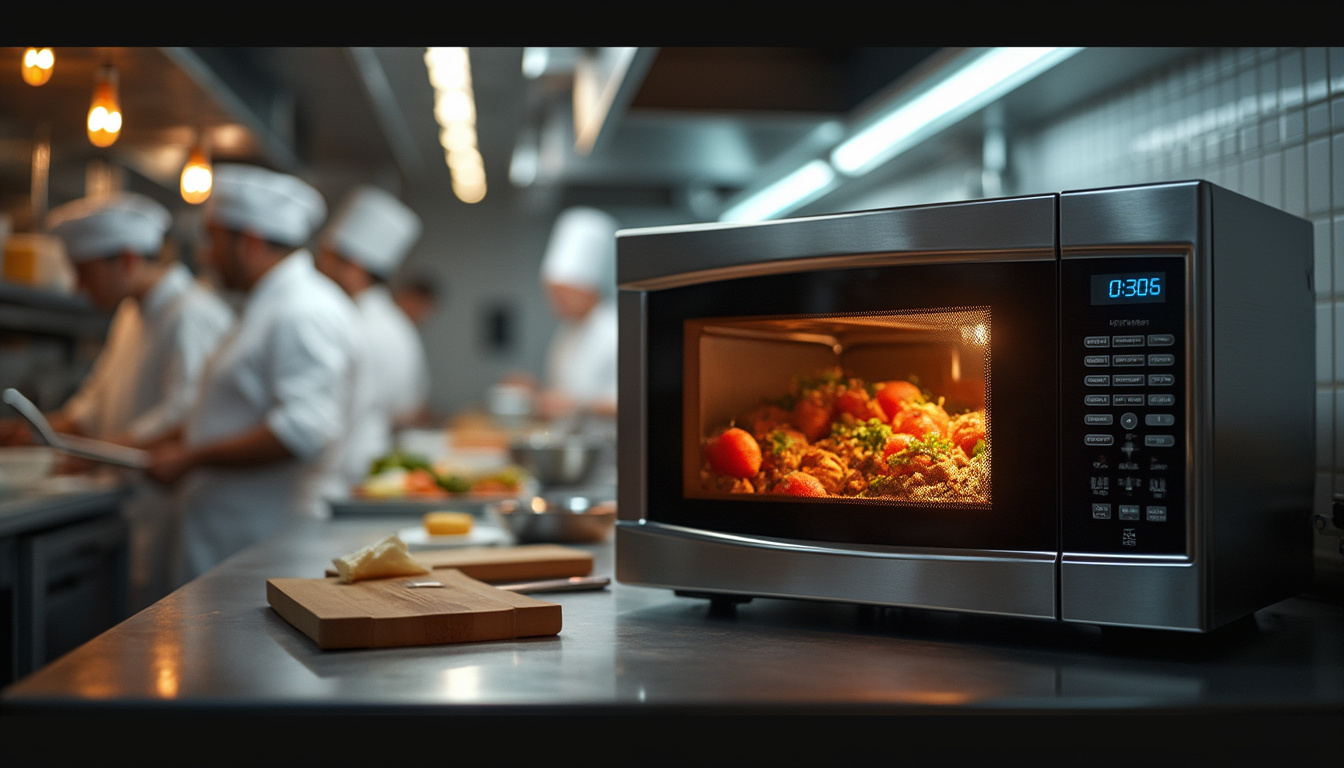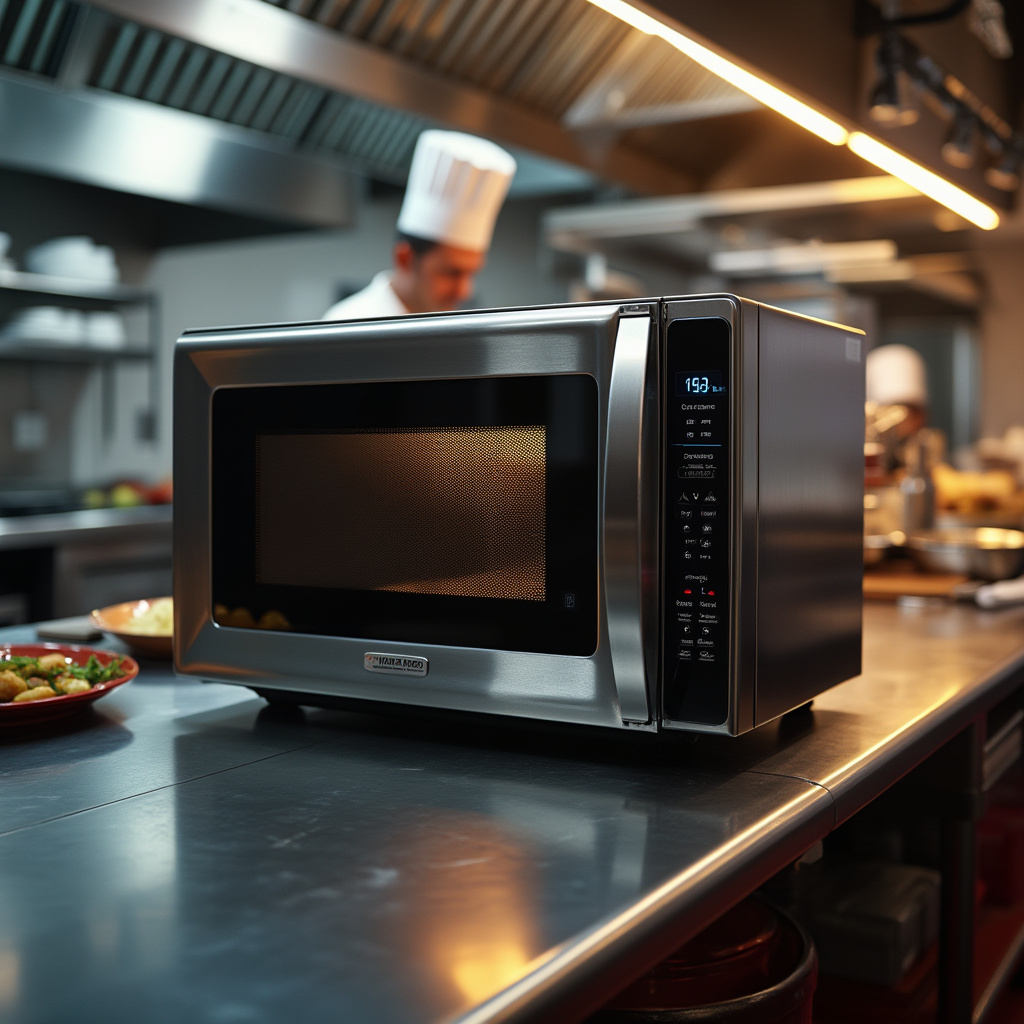Commercial Microwaves: An Overview
In the fast-paced environment of professional kitchens, commercial microwaves stand out as indispensable tools, offering unparalleled power and functionality that surpass their domestic counterparts. These microwaves are not just about reheating food; they are integral to maintaining efficiency and food quality in high-volume settings.
The most notable distinction between commercial and domestic microwaves lies in their power output. While domestic models typically range from 1000 to 1200 watts, commercial microwaves offer significantly higher wattage, categorized as light-duty (1000-1200 watts), medium-duty (1200-2000 watts), and heavy-duty (up to 5000 watts). This classification, based on daily usage, is particularly relevant in Canada, where the choice of duty level or volume is crucial for optimal performance.
Size is another critical factor. Commercial microwaves boast larger capacities, eliminating the need for a rotating tray and maximizing space utilization. This design allows for heating larger portions or multiple items simultaneously, making them a practical choice for busy kitchens.
Durability is a hallmark of commercial microwaves. Constructed with robust materials, they are designed to withstand the rigors of frequent, heavy use, ensuring longevity and reliability in professional settings.
Innovative features further enhance their utility. Programmable buttons, preloaded recipe times, and USB ports for transferring custom settings between units are modern conveniences that streamline operations, ensuring efficiency and consistency across multiple units or locations.
Selecting the right model involves considering several factors: daily usage volume, types of food being heated, available kitchen space, power requirements, and budget constraints. By evaluating these aspects, one can choose a commercial microwave that best suits their kitchen’s needs, thereby enhancing efficiency and food quality.
Delving Deeper into Commercial Microwave Features
When considering the power output of commercial microwaves, it’s essential to think about how different wattages can be applied in various kitchen environments. For example, a light-duty microwave, with its 1000-1200 watts, is ideal for smaller establishments or those with limited space, providing adequate heating without excessive power consumption. On the other hand, a heavy-duty model, reaching up to 5000 watts, is better suited for high-volume restaurants where quick turnaround is crucial, ensuring that large quantities of food can be heated rapidly without compromising quality.
The size and design of commercial microwaves play a significant role in kitchen workflow. Many models feature a cavity size that can accommodate large, commercial-sized dishes, allowing for heating multiple portions at once. This not only saves time but also optimizes kitchen space, as the need for multiple smaller microwaves is eliminated. Some units even come with specially designed racks or shelves to enhance capacity, making them a practical choice for bustling environments where every inch of space counts.
Durability extends beyond the physical construction of the microwave. Many commercial models feature a stainless steel interior and exterior, which are easy to clean and resistant to corrosion. This durability is complemented by robust door hinges and handles, designed to withstand frequent use. Additionally, some microwaves come with features like a heavy-duty magnetron, which is built to handle the rigors of constant operation, ensuring longevity and reliability in the most demanding settings.
In terms of innovative features, some commercial microwaves now include advanced sensors that automatically adjust cooking time based on the moisture levels of the food. This technology helps prevent overcooking and ensures that dishes are heated evenly. Furthermore, some models offer multi-stage cooking, allowing users to program different power levels and cooking times in sequence, which is particularly useful for complex recipes or for achieving specific textures in cooked foods.
Maintenance is another crucial aspect to consider. Commercial microwaves often come with features that make cleaning easier, such as removable shelves and drip trays, which can be washed separately. Regular maintenance, such as cleaning the magnetron and ensuring good ventilation, can significantly extend the life of the microwave and maintain its performance over time.
Safety features are also a priority in commercial microwaves. Many models include automatic shut-off in case of malfunction or if the door is opened during operation. Some units also have child safety locks, which can be activated to prevent accidental use. Additionally, certain microwaves are designed with cool-touch exteriors, reducing the risk of burns during operation.
Energy efficiency is another factor that has gained attention in recent years. Some commercial microwaves are designed with energy-saving features, such as lower standby power consumption or smart sensors that reduce energy use when the microwave is not in active use. These features can help reduce operational costs and contribute to a more sustainable kitchen environment.
Integration with other kitchen appliances is also an area of innovation. Some commercial microwaves can be integrated with existing kitchen management systems, allowing for seamless operation and monitoring. This integration can enhance workflow efficiency and help in maintaining consistency across all aspects of food preparation.
In conclusion, while the initial overview provided a foundational understanding of commercial microwaves, delving deeper into their features and applications reveals the breadth of their utility in professional kitchens. From power and size to maintenance and integration, each aspect plays a crucial role in enhancing kitchen efficiency and food quality. As technology continues to evolve, commercial microwaves are likely to become even more sophisticated, offering even greater benefits to foodservice operations.

Conclusion
Commercial microwaves are indispensable assets in professional kitchens, offering unmatched power, durability, and innovative features that cater to the demands of high-volume foodservice operations. Unlike domestic microwaves, their robust construction, higher wattage, and larger capacities make them ideal for heating large portions efficiently while maintaining food quality. Whether it’s a light-duty model for smaller establishments or a heavy-duty unit for bustling restaurants, selecting the right commercial microwave involves careful consideration of power output, size, maintenance needs, and advanced features like sensors and programmable settings. By investing in a suitable commercial microwave, businesses can enhance kitchen efficiency, reduce operational costs, and ensure consistent food quality. As technology advances, these microwaves are poised to become even more integral to modern kitchen workflows.
Frequently Asked Questions
What is the main difference between commercial and domestic microwaves?
Commercial microwaves are designed for heavy-duty use, offering higher power output (up to 5000 watts), larger capacities, and robust construction compared to domestic microwaves, which typically range from 1000 to 1200 watts and are built for household use.
How do I choose the right size for my commercial microwave?
Consider your kitchen space, the volume of food you need to heat, and the types of dishes you prepare. Larger cavities accommodate bigger portions or multiple items, while compact models are better for limited spaces.
What maintenance is required for a commercial microwave?
Regular cleaning of the interior and exterior, checking and replacing worn parts, and ensuring proper ventilation are essential. Many models feature removable shelves and drip trays for easy maintenance.
Are commercial microwaves energy efficient?
Yes, many modern commercial microwaves include energy-saving features like smart sensors and lower standby power consumption, helping reduce operational costs and environmental impact.
What safety features should I look for in a commercial microwave?
Key safety features include automatic shut-off, child safety locks, and cool-touch exteriors. These features help prevent accidents and ensure safe operation in busy kitchens.
Can commercial microwaves handle high-volume operations?
Yes, heavy-duty commercial microwaves are designed to handle high-volume operations, with powerful wattage and large capacities that allow for quick and efficient heating of large quantities of food.

Leave a Reply